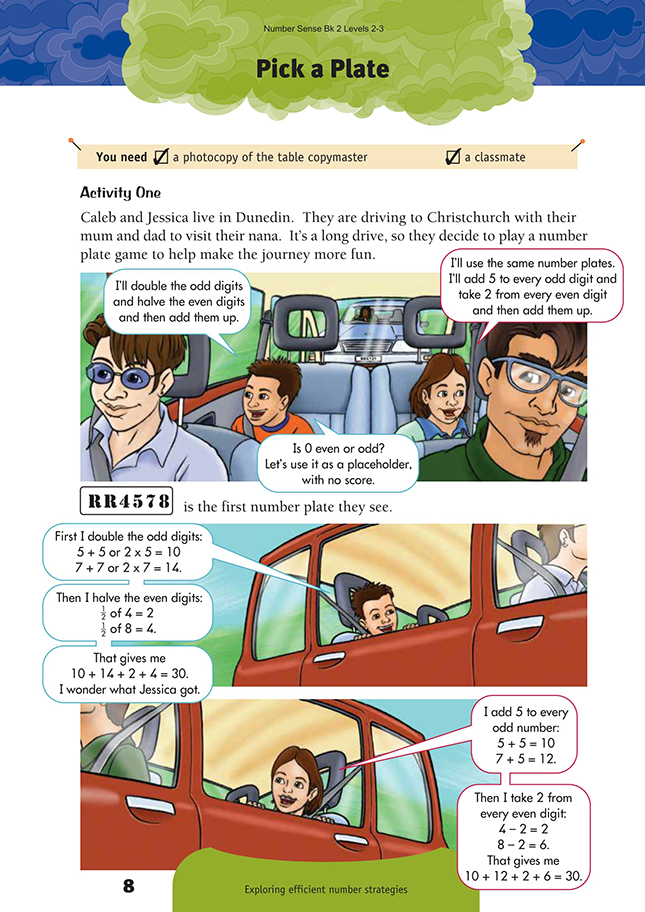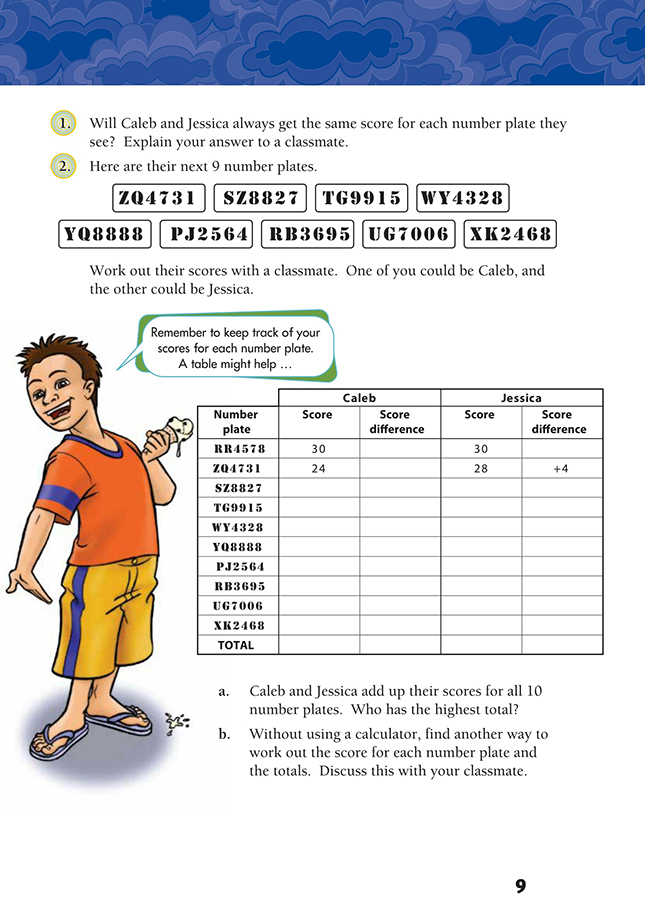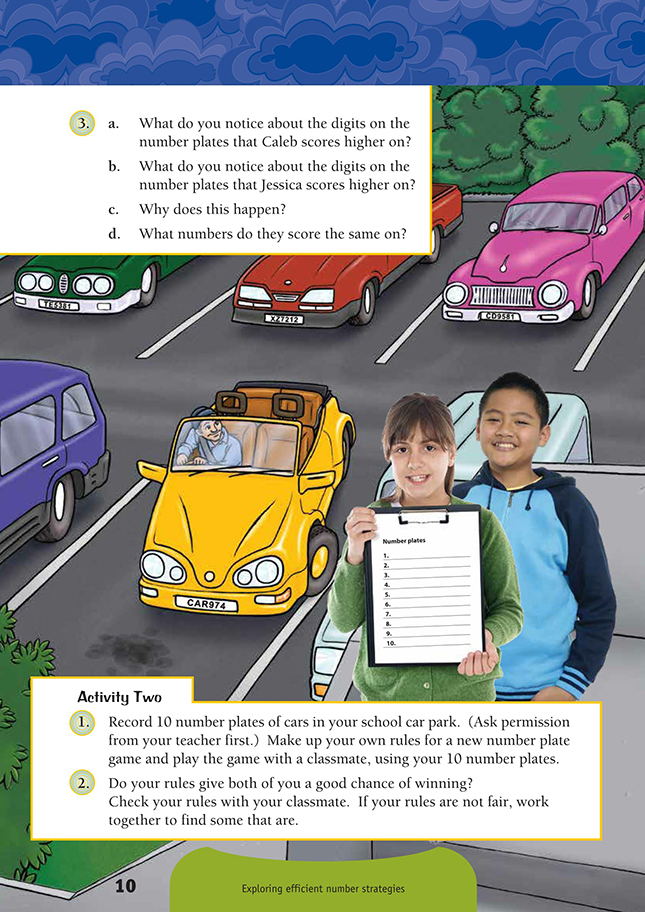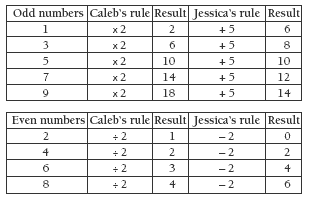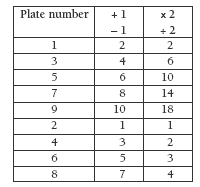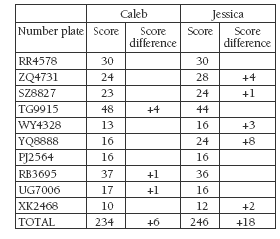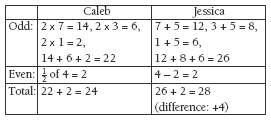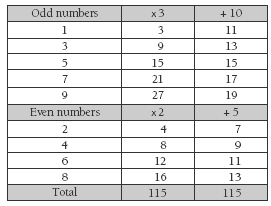This is a level 2 number activity from the Figure It Out series. It relates to Stage 5 of the Number Framework.
Click on the image to enlarge it. Click again to close. Download PDF (439 KB)
use addition and subtraction facts
use mental strategies to add numbers
Number Framework Links
Use these activities to:
• help the students who are beginning to use early additive strategies (stage 5) to become confident at this stage in the domains of addition and subtraction and multiplication and division
• develop the students’ knowledge of basic facts to stage 6.
A classmate
FIO, Levels 2-3, Number Sense and Algebraic Thinking, Book Two, Pick a Plate, pages 8-10
Copymaster of Table
This interesting calculation game will be useful as an ongoing maintenance activity both at and outside school. The activities use the number-plate context to encourage a variety of strategies for calculating. They also encourage the students to compare the effects on large and small digits of addition and subtraction and multiplication and division. The students then have an opportunity to generalise the effect of these operations on the numbers involved.
Activity One
Some students will be able to work through this activity independently, but do ensure that they understand the structure of the game. They may want to discuss whether the highest or lowest score wins. Check that they realise that the letters on the plates are not important.
With a guided teaching group, ensure that the students notice that both Jessica and Caleb got the same result for the first number plate, even though Caleb multiplied and divided and Jessica added and subtracted.
Question 1 makes the students focus on exploring the effects of the different strategies that Caleb and Jessica use. Use questions such as:
Which strategy would you expect to get the highest number most of the time?
Will there always be the same number of odd numbers and even numbers on the plate?
Is there a strategy that is better for a plate with more digits that are large numbers?
There are more odd number digits than even ones. Will this make a difference? (No. It depends more on whether the digits are high or low.)
In question 2, the students will probably work out the odd numbers and the even numbers separately and then combine them. Caleb multiplies all the odd numbers by 2, so he can either multiply each separately and then add them together or add them all first and then multiply by 2. He also has two options for even digits, but this time he would divide by 2.
A model for recording each of these two strategies on the plate ZQ4731 for Caleb could be:
Another model is:
Question 3 is the place for an in-depth comparison of each set of rules. Have the students develop a chart that they can use to explore the effect of the rules on each digit. For example:
Overall gain: Jessica will gain 2 more than Caleb, so she should win more often if the rule is that the highest score wins.
Activity Two
Strategies that will work for a new number-plate game may include alternating the highest total and the lowest total as the winning scenario. The students should focus on strategies for their games where both people will have a close-to-equal chance of winning. For example, have the students explore the scenario where one player adds 1 to odd numbers and subtracts 1 off even numbers and the other player doubles the odd numbers and halves the even numbers. A chart for this rule would be:
Although the +1, – 1 player wins on 3 out of 9 and loses on 4 out of 9, the effect of the differences is greater for the x 2, ÷ 2 player (+ 20, compared to + 6 for the + 1, – 1 player).
The rule suggested in the Answers for question 2 is to change the calculations for odd and even numbers, which will give both players the same chance of winning. If the students use the chart approach suggested there or above, they will be able to quickly see whether their suggested rules are fair to each player.
A good discussion point is the fact that even a “fair” rule such as that in the Answers is no guarantee of success. For example, that rule applied to Caleb and Jessica’s number plates gives Caleb a difference of + 28. In the end, it all depends on the range of digits in the number plates used.
Extension
Using the rule given in the Answers, have the students make a chart to examine the effect the calculations have on each number and discuss the outcomes.
A different game using number-plate numbers is to try to use all the numbers to reach a target number, say 10. The players can use the numbers once only and can combine them using any operation. For example, in WZ7283, 8 – 3 = 5, then 7 + 5 = 12, and finally 12 – 2 = 10.
Answers to Activity
Activity One
1. No. Explanations may vary. Caleb will often get more than Jessica when he doubles the odd numbers (for example, for the 9 in a number plate such as TS9696, Caleb would score 2 x 9 = 18 and Jessica would score 9 + 5 = 14).
But Caleb has to halve the even numbers (for example, of 6 = 3), whereas Jessica only subtracts 2 (for example, 6 – 2 = 4). So with TS9696, Caleb would score 18 + 18 + 3 + 3 = 42 and Jessica would score 14 + 14 + 4 + 4 = 36.
2. a. Jessica has the highest total score. The table could look like this:
One way to score ZQ4731 is:
b. Methods will vary. Possible ways include:
Caleb: Add up the odd numbers and double that total, then add up the even numbers
and halve that total. Add up the 2 new totals to get the final total.
Jessica: Add up the odd numbers, then count the number of odd digits and multiply that by 5. Then add both totals together to get your odds total. Add up the evens, count the number of even digits and multiply that by 2, then subtract that from your evens total. Add up the new odds and evens totals to get the final total.
To find the overall winner, add up the positive score differences. (For example, in
the answer table for question 2a, Caleb’s positive differences add up to 6 and Jessica’s to 18, so Jessica wins by 12.)
3. a. Caleb usually scores higher on number plates that have at least 1 odd digit higher than 5 and that have lower even digits (if there are any).
b. Jessica usually scores more on number plates that have 2 or more of the higher even digits and that have lower odd digits (if there are any).
c. Caleb scores more when he doubles 7 or 9 than Jessica does when she simply adds 5. Jessica scores more when she subtracts 2 from 6 or 8 than Caleb does when he halves them.
d. 5 and 4
Activity Two
1. Practical activity. Answers will vary.
2. Rules will vary. A rule that will give both players the same chance of winning is: one player could multiply odd numbers by 3 and even numbers by 2, and the other player could add 10 to odd numbers and add 5 to even numbers.
You could show this on a chart:
Note that, although this gives both players the same chance of winning, the actual winner still depends on the number plates used. For example, for Caleb and Jessica’s number plates in Activity One, Caleb would score 506 and Jessica would score 480, a difference of 26.
